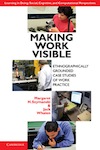Books on ethnography and ubiquitous computing by PARC researchers
Based on the deep research and collective experience of PARC and other practitioners, both books draw on extensive case studies or field experience to make the areas they cover more accessible for broader audiences. The books highlight how innovations and business applications in these areas have and can give companies a real competitive edge, especially in today’s environment, where products are always at risk of being commoditized, the services sector increasingly dominates economic activity, and global competition is intensifying.
In Making Work Visible: Ethnographically Grounded Case Studies of Work Practice (Cambridge University Press, April 2011), Peggy Szymanski and co-editor Jack Whalen share how “ethnography†engagements are conducted, and how findings from these studies can lead to business impact. By applying naturalistic observation in different contexts to understand what people actually do – as opposed to only what they say they do – ethnography makes the unknown known, makes the tacit explicit, and reveals insights that would not otherwise be revealed. The embedding of social scientists in technology companies (often referred to as corporate ethnography) was pioneered at PARC in the 1970s, and has evolved here and elsewhere since. Drawing on contributions from PARC, Xerox, and other researchers throughout the world, this book demonstrates how ethnography can improve technology design and help develop better ways of working. The book focuses on case studies in production, office, home, and retail settings – including the critical “customer front.â€
In Ubiquitous Computing for Business: Find New Markets, Create Better Businesses, and Reach Customers Around the World 24-7-365 (Financial Times Press, March 10, 2011), Bo Begole shares how companies can incorporate this game-changing technology into their products, services, processes, and strategies while mitigating their risks, making better decisions about “build vs. buy,” and sorting hype from real value. Conceived at PARC in the 1990s, the paradigm of ubiquitous computing – pervasive, mobile devices; embedded sensors and data; and seamless integration across physical and digital worlds – has recently exploded in the form of pervasive personalized devices and services. From the Web to the iPod, smart phones to social networks, “Ubicomp†technologies continue to interweave computing more deeply into human life than ever before, enabling massive new industries and destroying companies that can’t adapt. The book describes the general capabilities that Ubicomp technologies create, the limitations they face, and their impact across industry categories. Begole shares proven strategies for leveraging Ubicomp technologies to drive business value, illustrated with a number of real-world innovation case studies.




